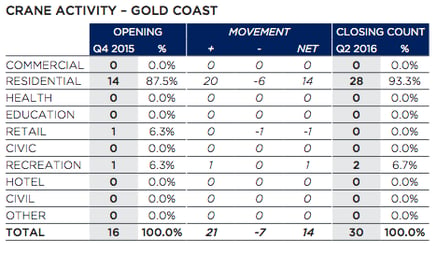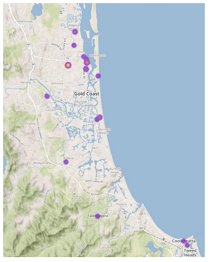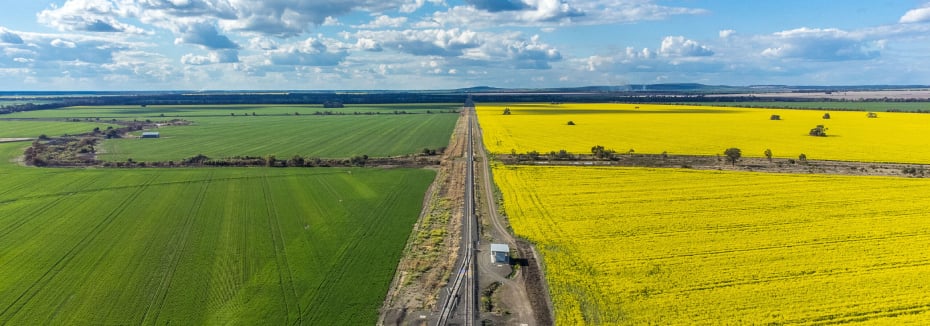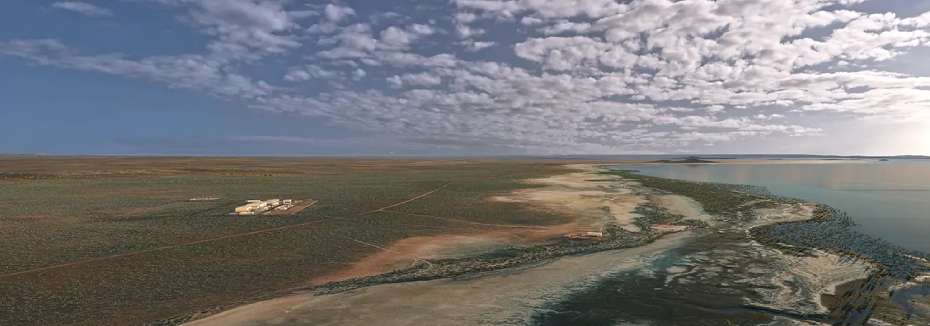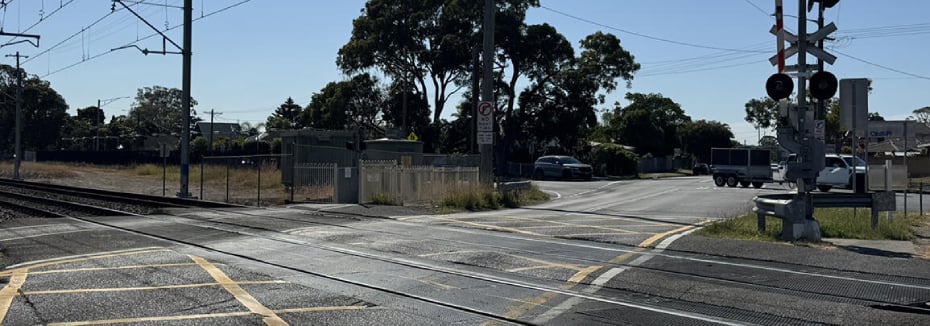The latest RLB Crane Index reports signs of strength in the Australian construction industry, with all major cities having recorded increased or neutral crane activity since last quarter. In an economy continuing to transition from the construction phase of mining to the production phase, 647 cranes working on construction sites around the country is a promising sign of activity.
Cranes in Australia: continuing strength of construction industry
Australia’s crane activity of 647 cranes was represented by significant growth in Sydney (76 crane increase), Canberra (11 crane increase), Gold Coast (14 crane increase) and Melbourne (12 crane increase). The additional 113 cranes erected in the past quarter represent a 20% increase since the last Crane Index (Q1 2016). The churn rate of cranes since the previous count was 80%, i.e. 80% of all cranes counted in the previous Crane Index were removed and erected on other sites around Australia. This churn rate highlights very strong levels of activity over the short term.
Sector activity within Australia is still dominated by the residential sector, accounting for 81% of all cranes recorded, representing 525 cranes.
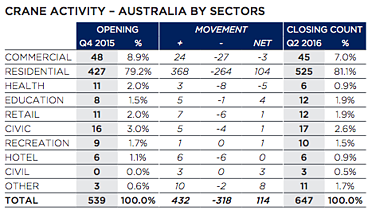
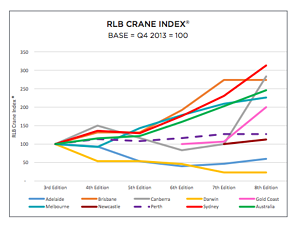
Of the 10 cities listed in the report, seven cities recorded an increase in the number of cranes erected, with Darwin showing no change and Perth the only city to reduce their crane count. Check out our quick city summary below!
Adelaide: strong residential and education sectors
With strong residential and educational sectors, crane hire in Adelaide has seen three new cranes have been erected and one crane removed from sites around the city. Six cranes remain from our previous index. All cranes are centred within the CBD. Adelaide’s construction work done fell slightly in 2015 from 2014 results by 2.2%, however RLB has observed an additional two cranes on Adelaide’s sky.
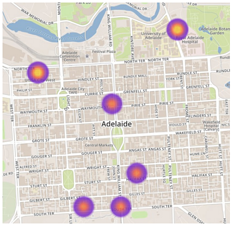
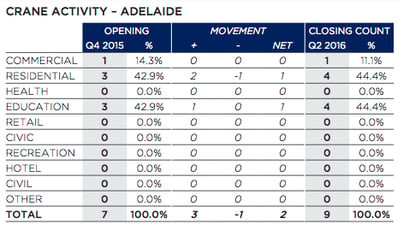
Brisbane: crane churn bodes well for 2016 pipeline
A total of 104 cranes were observed in Brisbane, the same number as our previous count. With 83 new cranes erected and 83 removed since our last count, 80% of all cranes counted in our last Crane Index were removed from projects nearing completion and moved to new developments within the city. This churn augers well for the pipeline of construction work and crane hire in Brisbane during 2016. As highlighted on the hotspot map below, Brisbane’s cranes appear to be equally centred on both the north and south sides of the river.
Strong growth in construction work done for 2015 over 2014 levels resulted in a 6.4% increase in residential and non residential work done. 2015 also saw a 5.5% increase on 2011 levels of construction work done.
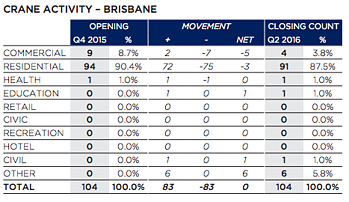
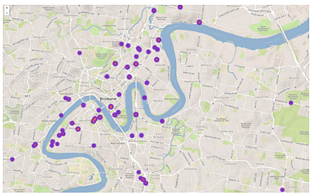
Canberra: nine new cranes erected for residential developments
Canberra’s construction market has seen an additional 11 cranes erected since our last index. There is now 17 erected cranes in Canberra, up from six. Residential developments account for 76% of all cranes seen in the nation's capital city.
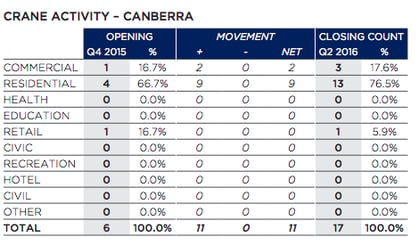
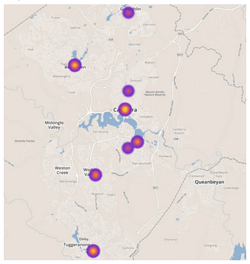
Darwin: three cranes remain at residential sites
Darwin cranes seen remain at three, the same as our last Crane Index with three residential cranes sited.
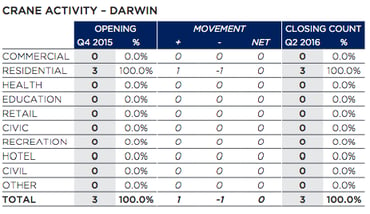
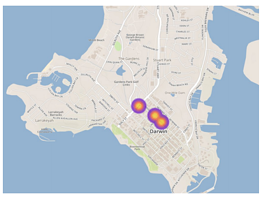
Gold Coast: 88% increase in activity with 14 new cranes recorded
The Gold Coast is seeing increased activity with a significant increase in cranes being recorded since our last Index. The coast has 30 cranes, an increase of 14 or 88% over our previous Index. Gold Coast crane hire suppliers are to capitalise on the boom of residential projects in the region, accounting for 93% of all cranes on the Coast.
Melbourne: continuing growth of city reflected in number of new fixed cranes
The lift in total cranes in Melbourne by 11 cranes to 148, was reflected by 82 new cranes erected in Melbourne and 70 removals since our last Index. The majority of cranes observed are located in the CBD fringe and the South East with little multi-storey construction occurring in the western suburbs.
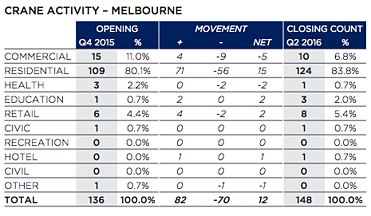
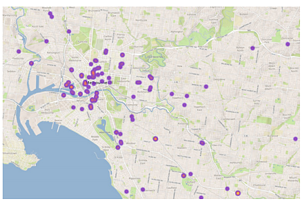
Newcastle: retail sector grows with two new cranes erected
In its inaugural year the Crane Index for the region around Newcastle has nine cranes installed on developments. This represents an additional crane since the last Crane Index. That puts Adelaide and Newcastle on level footing, which is not believed to have been seen before. 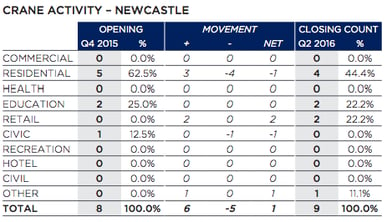
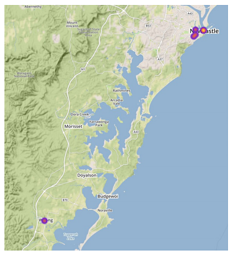
Perth: slight decrease in cranes on residential projects
Perth has seen a slight decrease in cranes since the last index. A total of 45 cranes in Perth, down from 47. Perth’s skyline is unique in Australia with only 55% of all cranes on residential sites. Recreation and hotel developments make a significant contribution to the overall count at 27%.The residential construction work done for the 2015 year reflected a 10% increase over 2014 results. This is reflected in the stable numbers of cranes seen in Perth since the last count.
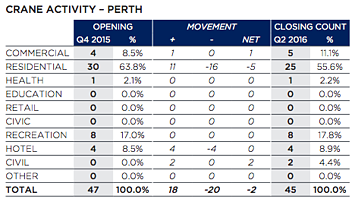
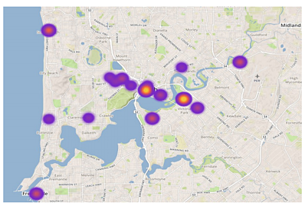
Sydney: crane count continues to grow with residential construction activities
The number of cranes on the skyline of Sydney continue to grow on the back of increasing construction activities which is being dominated by the rise in the residential sector (accounts for 83% of all cranes erected). Sydney currently has 288 cranes on construction sites around Sydney.
A rise of 44% in residential work done to over $10b in 2015 over 2011 levels is complemented by an additional 16% increase in construction work done in the non-residential sector, highlighting the current strength of Sydney’s construction sector. This increase in construction work is reflected in the 288 cranes observed around Sydney.
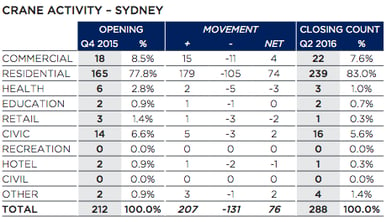
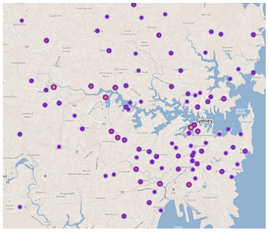
The surge in the residential sector has helped lift confidence in the property and construction industries in the past quarter. So with housing, apartment, multi-storey projects continuing to grow, it's a powerful tool to know how to get the best value rates for your project.
Construction professionals that understand the changing market are better equipped to provide value to their client. We know it’s time consuming to research this from scratch, so we’ve written a guide on the 7 Factors Affecting Plant Hire Rates. Download your eBook today by clicking below!

Recent Articles
NSW Govt approves Inland Rail Narrabri to North Star Phase 2 project
Delivery of the second phase of Inland Rail in New South Wales will soon get underway as the State Government gives the green light to the Narrabri to North Star Phase 2 project.
New significant milestones reached on proposed Northern Water Project
Two significant milestones have been achieved on the proposed Northern Water desalination plant in South Australia.
Plans unveiled for major upgrade to NSW Rawson Rd level crossing
The New South Wales Government has unveiled plans for a major upgrade at Rawson Road and Railway Street in Woy Woy to make one of the Central Coast’s level crossings safer.
Get the latest project news
- updates on Australia's pipeline of state and federal projects
- fresh contract awards from major contractors and builders
If you're looking to contact us about other matters, please contact us.

